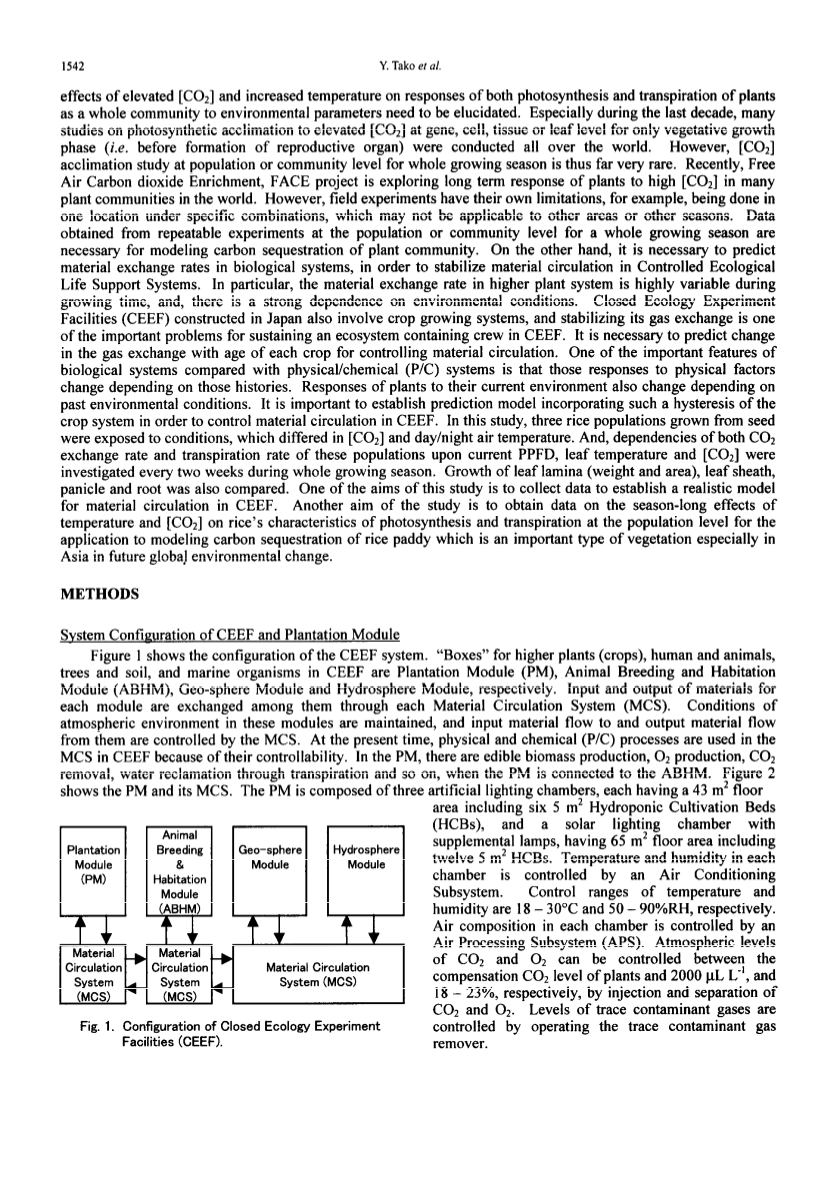环境变化背景下的模拟封闭式生态系统实验设施对植物气体交换和蒸腾作用的应用外文翻译资料
2022-12-02 19:26:49


英语原文共 5 页,剩余内容已隐藏,支付完成后下载完整资料
论文翻译
题 目 环境变化背景下的模拟封闭式生态系统实验设施 对植物气体交换和蒸腾作用的应用
目录
摘要 3
关键词 3
Abstract 3
Key words 3
引言 4
1.研究方法 5
2.植物栽培法 7
3.相关参数反应研究 8
4.结果与调查 8
5.致谢 10
参考文献 11
环境变化背景下的模拟封闭式生态系统实验设施对植物气体交换和蒸腾作用的应用
Y. Tako, R. Arai, K. Otsubo and K. Nitta
Institute for Environmental Sciences (IES), l-7 ienomae, Obuchi, Rokkasyo-mura, Kamikita, Aomori, 039-3212 Japan.
摘要:随着未来大气中CO2浓度的不断上升,温度、大气中的CO2、长时期的高浓度CO2和高温环境对植物光合作用和蒸腾作用产生很大的影响。因此为了预测未来值被的碳固定情况,需要阐明植物在社会环境变化的过程中的具体参数。特别是在过去的十年里,在世界各地进行的有关光合适应性的实验仅仅局限在基因、细胞、组织或叶水平,即仅在营养生长阶段提高CO2浓度 (即前生殖器官的形成)。然而,在植物种群或群落的层次上的对于CO2的环境适应性的研究在整个生长季节是非常罕见的,因此在植物种群和群落水平上通过可重复试验获得的数据对于植物群落碳固定的建模是很有必要的。另一方面,为了稳定人工生态系统物质循环的封闭生态实验设施(CEEF),有必要对生态系统的物质交换比率进行预测。尤其在高等植物的高变量增长时期,植物的物质交换比率对环境条件有一种强烈的依赖性。出于这个原因,基于三种水稻品种在CO2浓度和日夜气温(350 L CO2 L-1,24/l7°C (种群A); 700L CO2 L-1, 24/17°C (种群B) 和 700L CO2 L-1, 26/19°C (种群 C))等不同条件下种子萌发的光量子通量密度、叶片温度和CO2与CO2交换比率和蒸腾速率的依赖关系,研究得出它的依赖关系周期大约为生长季节中每两周一次。植物叶片、叶鞘、穗和根的增长也可类比,这个实验阐明,出现在水稻营养生长期的CO2浓度影响其光合作用的瞬时反应,从而影响叶面积和植物干重的变化比率。但是,在生殖生长阶段(即穗形成后),种群A和种群B对于CO2所引起的光合作用的反应产生差异,种群B有所减少。尽管种群C的叶面积指数总是小于种群C,但是处在24°C的种群A和处在26°C的种群C在整个生长期内CO2浓度的变化对它们光合作用的影响几乎没有差异。这些结论对于水稻种群碳固定模型的建立十分有用,特别是对于预测亚洲的植被类型在未来环境中所产生的变化。
APPLICATION OF CROP GAS EXCHANGE AND TRANSPIRATION DATA OBTAINED WITH CEEF TO GLOBALCHANGE PROBLEM
Y. Tako, R. Arai, K. Otsubo and K. Nitta
Institute for Environmental Sciences (IES), l-7 ienomae, Obuchi, Rokkasyo-mura, Kamikita, Aomori, 039-3212 Japan
Abstract
In order to predict carbon sequestration of vegetation with the future rise in atmospheric CO2 concentration, CO2 and temperature, long term effects of high CO2 and high temperature on responses of both photosynthesis and transpiration of plants as a whole community to environmental parameters need to be elucidated. Especially in the last decade, many studies on photosynthetic acclimation to elevated CO2 at gene, cell, tissue or leaf level for only vegetative growth phase (i.e. before formation of reproductive organs) have been conducted all over the world. However, CO2 acclimation studies at population or community level for a whole growing season are thus far very rare. Data obtained from repeatable experiments at population or community level for a whole growing season are necessary for modeling carbon sequestration of a plant community. On the other hand, in order to stabilize material circulation in the artificial ecological system of Closed Ecology Experiment Facilities (CEEF), it is necessary to predict material exchange rates in the biological systems. In particular, the material exchange rate in higher plant systems is highly variable during growth periods and there is a strong dependence on environmental conditions. For this reason, dependencies of both CO2 exchange rate and transpiration rate of three rice populations grown from seed under differing conditions of CO2 and day/night air temperature (350 L CO2 L-1,24/l7°C (population A); 700L CO2 L-1, 24/17°C (population B) and 700L CO2 L-1, 26/19°C (population C)) upon PPFD, leaf temperature and CO2 were investigated every two weeks during whole growing season. Growth of leaf lamina, leaf sheath, panicle and root was also compared. From this experiment, it was elucidated that acclimation of instantaneous photosynthetic response of rice population to CO2 occurs in vegetative phase through changes in ratio of leaf area to whole plant dry weight, LAR. But, in reproductive growth phase (i.e. after initiation of panicle formation), the difference between photosynthetic response to CO2 of population A and that of population B decreased. Although LAR of population C was almost always less than that of population A, there was no
difference between the photosynthetic response to CO2 of population A at 24°C and that of population C at 26°C for its whole growth period. These results are useful to make a model to predict carbon sequestration of rice community, which is an important type of vegetation especially in Asia in future global environmental change.
引言
二氧化碳(包括大气中的CO2)和温度是影响植物生长发育和功能的关键变量,并在从过去到现在一直处于变化之中,也可以预测到未来的变化。上个世纪,平均CO2浓度增加至约280-360·L-1。
二氧化碳量的增长比率将持续到二十一世纪,这使目前的CO2浓度是上个世纪后半叶的两倍。将人口增长和经济活动考虑在内,预计到本世纪末,它的浓度将达到700·L-1 (Morison and Lawlor, 1999).在预测结果中,CO2浓度的增长以及其他温室气体导致地球表面温度上升。最近的模型预测表明,全球平均表面空气温度在本世纪将会由1℃增长到4.5℃。(kattenberg et al.,1996).气候带来的变化可能导致植物的生长发育。因此由于CO2的增加所导致的未来植被的碳吸收增加,以及温度升高、长期的高浓度CO2环境导致的一系列问题需要进行科学预测,如:对植物光合作用、蒸腾作用等的影响,并且相关的社会环境参数也是研究的重点。特别是在过去的十年中,世界各地都进行着关于研究光合适应性的实验,他们在基因、细胞、组织或叶片等植物生长发育层面上(即形成生殖器官以后)进行着关于CO<sub
剩余内容已隐藏,支付完成后下载完整资料</sub
资料编号:[29178],资料为PDF文档或Word文档,PDF文档可免费转换为Word




